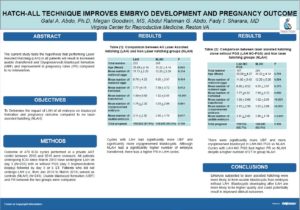PRELIMINARY RESULTS FOR ANEUPLOIDY SCREENING IN SOUTH ASIAN WOMEN COMPARED TO CAUCASIANS UNDERGOING PGS.
Fady I. Sharara, MD, Megan Goodwin, MS, Galal Abdo, PhD.
 Objective: Previous studies have shown lower pregnancy rates following blastocyst transfers in South Asian women compared to Caucasians despite a younger age in South Asians (Shahine 2009, Sharara 2012). No clear hypothesis has been able to explain this difference. We investigated whether such disparities existed when embryo euploidy was controlled for.
Objective: Previous studies have shown lower pregnancy rates following blastocyst transfers in South Asian women compared to Caucasians despite a younger age in South Asians (Shahine 2009, Sharara 2012). No clear hypothesis has been able to explain this difference. We investigated whether such disparities existed when embryo euploidy was controlled for.
Design: Retrospective cohort study
Materials and Methods: Outcomes of autologous IVF cycles performed at a private ART center between 1/2014 and 4/2016 were reviewed. All patients underwent day 5 trophectoderm biopsy (Genesis Genetics, Detroit, MI), and a subset had fresh day 6 ET.
Results: There were 85 cycles included in this analysis: 55 cycles in Caucasians (C) and 30 cycles in South Asians (SA). South Asians were significantly younger, (37.4 vs 35.3 years in C vs SA, respectively, P=0.003) and had higher AMH levels (2.30 vs 4.38 ng/ml, in C vs SA, respectively, P=0.006) and lower gonadotropin use (3045 vs 2495 IUs in C vs SA, respectively, P=0.041). There were no differences in the number of oocytes retrieved (10.6 vs 12.8 in C vs SA, respectively, P=0.15), MII oocytes retrieved (8.1 vs 9.6 in C vs SA, respectively, P=0.18), fertilization rates (91.4 vs 90.4 % in C vs SA, respectively, P=0.72), or peak progesterone (0.86 vs 0.90 ng/ml in C vs SA, respectively, P=0.73) or peak estradiol (1417 vs 1615 pg/ml in C vs SA, respectively, P=0.44) on the day of HCG administration. A larger proportion of embryos developed to the blastocyst stage and were biopsied in Caucasians compared to South Asians (52.3 vs 36.2 % in C vs SA, respectively, P=0.001), and a trend was noted toward a higher incidence of aneuploid embryos in Caucasians (54.1 vs 41.2 % in C vs SA, respectively, P=0.09). There was, however, no difference in the proportion of embryos that yielded no result (9.0 vs 12.1% in C vs SA, respectively, P=NS). In 40 cycles with fresh day 6 ET (26 in C and 14 in SA), Caucasians tended to have more embryos transferred (1.37 vs 1.13 in C vs SA, respectively, P=0.083) and a higher clinical pregnancy rate than South Asians (69.2 vs 28.6 % in C vs SA, respectively, P=0.014).
Conclusions: As far as we know, this is the first study comparing outcomes between South Asian and Caucasian women undergoing PGS for aneuploidy screening followed by fresh day 6 ET. While significantly younger with higher AMH levels and requiring less gonadotropins, South Asian women produced fewer biopsied blastocysts and had a lower clinical pregnancy rate than Caucasians. In this study, both embryo euploidy and endometrial receptivity were accounted for, indicating that the difference in ART success may be attributed to other possibly non-reproductive factors. Larger studies are needed to confirm or refute our findings, and FET outcomes need to be evaluated. Our study is ongoing.
Support: None
